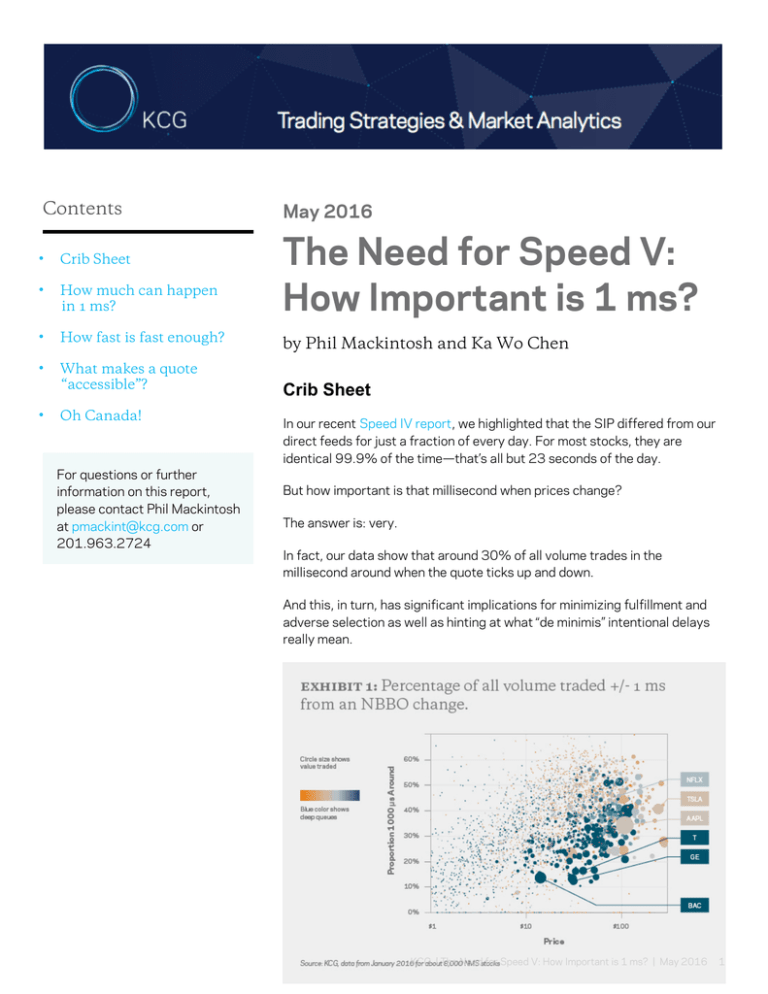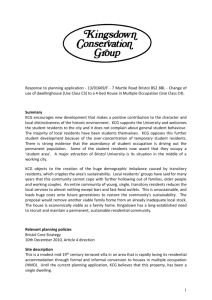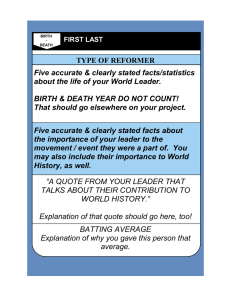
Contents
•
Crib Sheet
•
How much can happen
in 1 ms?
•
How fast is fast enough?
•
What makes a quote
“accessible”?
•
Oh Canada!
For questions or further
information on this report,
please contact Phil Mackintosh
at pmackint@kcg.com or
201.963.2724
May 2016
The Need for Speed V:
How Important is 1 ms?
by Phil Mackintosh and Ka Wo Chen
Crib Sheet
In our recent Speed IV report, we highlighted that the SIP differed from our
direct feeds for just a fraction of every day. For most stocks, they are
identical 99.9% of the time—that’s all but 23 seconds of the day.
But how important is that millisecond when prices change?
The answer is: very.
In fact, our data show that around 30% of all volume trades in the
millisecond around when the quote ticks up and down.
And this, in turn, has significant implications for minimizing fulfillment and
adverse selection as well as hinting at what “de minimis” intentional delays
really mean.
KCG | The Need for Speed V: How Important is 1 ms? | May 2016 1
.
How much can happen in 1 ms?
In our recent Speed IV report, we highlighted that the SIP differed from our
direct feeds for just a fraction of every day. For most stocks, they are
identical 99.9% of the time—that’s all but 23 seconds of the day.
We also found that the SIP is typically less than 1 ms slower than the direct
feeds—even after we add back the extra distance the SIP needs to cover to
get to our servers.
But how important is that millisecond?
The answer is that it matters a lot more than you’d think.
Around 30% of all trading happens as quotes change
Although it represents less than 0.1% of the day for most stocks, the time
when quotes are changing represents an average of 29.4% of all value
traded (Exhibit 1).
Avoiding adverse selection is hard
From the perspective of the liquidity provider, the fills that cause a quote
change also result in adverse selection—something we talked about in
Speed I. Adverse selection is often measured by the mark-out—or the change in the
mid price after the trade. As Exhibit 2 shows, the mid-point AFTER the trade
is actually at a better price than the fill you just received. Considered another way—you would have been better off to not have been
on the offer at that time as:
•
•
The worst price you would expect now is the price of your fill.
There is a chance to capture the new spread—and improve your fill
prices by a whole cent.
Unless you have perfect foresight into the market, using it in venue analysis
can give misleading results.
KCG | The Need for Speed V: How Important is 1 ms? | May 2016 2
Higher stock prices increase adverse selection
The data also shows that adverse selection happens more often for higherpriced stocks, which makes sense because the 1-cent spread represents a
smaller return (in bps). Consequently, the return from posting liquidity is
lower, which, in turn, reduces the depth of book.
KCG | The Need for Speed V: How Important is 1 ms? | May 2016 3
Fade hurts too
The only way we could allow traders to avoid adverse selection—the ability
to back away from the touch before liquidity takers can trade—is to say that
slowing down takers, to allow fade, is OK.
But even if we did that—our data shows that fading will significantly reduce
the liquidity you interact with as a liquidity provider—which may, if the stock
moves adversely, increase the total costs of a trade. How fast is fast enough?
Is 1 ms enough to affect executions?
The short answer is: yes.
The long answer is: only if traders operate at different speeds.
Fade and adverse selection are both bad for investors
Both fade and adverse selection detrimentally affect trade prices for longterm investors.
•
To avoid adverse selection a liquidity provider needs to fade faster
than anyone else can route.
•
To avoid fade, a liquidity taker needs to route faster than anyone else
can fade.
Note that fade and adverse selection are opposites—you can’t artificially fix
both at once.
An equal market is fair
Both fade and adverse selection require a difference in trading speed. This
means the fairest market should be one where nobody has a speed
advantage. Where all trades happened in the order that decisions were
made.
This would be possible if everyone could trade at the actual speed of
light—with no processing times—as we showed in our routing visualization.
To achieve this both takers and providers need to calibrate their systems to
process at equal speeds.
Equal is impossible
But processing is required in multiple places—and as we saw for the
SIP—something as simple as the level of trading activity can slow a
processor down.
KCG | The Need for Speed V: How Important is 1 ms? | May 2016 4
A while ago, Matt Levine wrote a thought-provoking comment on how this
makes the idea of “fair” a relative concept.
How different is important
In theory, a difference as small as just 25 µs may be important—as this
represents the difference in our routing visualization between the takers'
direct route to Nasdaq versus a message traveling to Nasdaq via BATS.
However our own fulfillment data suggest even larger differences might not
matter. We use proprietary fiber to route orders, instead of microwave, as it
has higher fidelity and bandwidth. Despite the fact this is around 65 µs
slower between NYSE and BATS, we still see almost no fade on any
exchanges.
Two IEX data points provide evidence of what level of delays are important:
1. In a recent IEX op-ed, they found that switching from slower FIX to
faster binary routes between their Weehawken-based ATS and the
NYSE increased their fulfillment materially. Note that this did nothing to
change the 114 µs distance between the two venues, as it was a
software change that sped up order processing. NYSE data suggests
this results in a speed improvement of around 1 ms.
2. Although the IEX POP is just 350 µs, it is in fact designed to allow peg
orders (which use direct feeds) to fade aggressive takers (who need to
traverse the POP).
KCG | The Need for Speed V: How Important is 1 ms? | May 2016 5
SEC proposal to define “immediate”
As we were writing this report, the SEC proposed a new
interpretation of the term “immediate” in Reg NMS, for the purposes
of determining an automatic quote.
Specifically, they propose that:
“…delays of less than a millisecond …may be … de minimis
…[and] would not impair…ability to access a quote.”
What makes a quote “accessible”?
Essentially, an accessible quote is one that can’t be faded.
As we’ve detailed, this depends on the difference in routing times between
takers and providers, not the length of time.
KCG | The Need for Speed V: How Important is 1 ms? | May 2016 6
For example:
*See a NJ-based example of this in our routing visualization.
How will a speed bump impact the market
There has been plenty written about IEX and its exchange approval. Based
on what we’ve covered in this and recent reports—it seems fair to say:
•
The POP itself, adding 350 µs to route times and 700 µs to fill times,
will probably create locked markets for longer times each time a marketwide quote change occurs—provided IEX has lit orders at the NBBO
(click on our SIP Visualization).
•
However as all limit orders also need to be canceled via the POP—they
should be accessible.
•
IEX peg order types, with a 350 µs head start on limit orders, are
designed to have enough time to fade a taker.
•
However, these orders are currently dark (see first bullet above)—so
they wouldn’t be protected anyway.
Given this, the potentially imminent approval of IEX, on its own, may be less
problematic than some suggest.
It depends if speed bump orders are lit
The real issue is that inaccessible quotes might end up “protected.”
KCG | The Need for Speed V: How Important is 1 ms? | May 2016 7
•
•
Reg NMS defines a protected quote as: a bid or offer…that…is
displayed (a lit quote) by an automated trading center.
Rule 611 specifically prevents “trade throughs” of protected quotations.
Consequently, routers cannot ignore any lit NBBO shares—even if they
knew that venue was inaccessible in a market-wide sweep route.
Other exchanges already have lit-peg order types—and IEX approval would
seem to create a precedent for a speed bump in those markets too.
If NYSE or Nasdaq or BATS (or IEX) combined a speed bump with a lit-peg
order type—those quotes could become inaccessible—even though they will
still be “protected.”
The result would be reduced fulfillment for takers, which most participants
seem to agree is bad.
Oh Canada!
Canada has been progressive with its own market structure since the credit
crisis. They restructured exchange ownership, reduced fragmentation,
added trade-at requirements and even approved speed bumps.
But what the US should take most notice of is a recent IIROC decision to
unprotect all speed bump quotes, “where an intentional order processing
delay results in the inability to provide an immediate execution against
displayed volume.”
Perhaps a similar solution would work in the US. Approve IEX, but be clear
that intentional delays on accessing lit orders will result in the loss of
protected status. Over time, that might even reduce speed-based order
types like Day-ISO.
How did we do this?
We use our tick level trade data, and summed all trades within +/- 1
millisecond of our timestamps on a SIP quote change.
Why did we use 1 ms around a quote change?
We know from our Speed III and Speed IV reports that:
•
It takes around 800 µs for the SIP to update.
•
All the trades that cause the NBBO to change occur BEFORE
the SIP updates.
•
Dark pool trades most likely take even longer to report, as they
need to post trades via the TRF.
KCG | The Need for Speed V: How Important is 1 ms? | May 2016 8
Going backward 1 ms before the SIP change, should capture most
of the trades on exchanges.
Going forward 1 ms allows extra time for slower dark pools to post
trades—as these have lower standards of immediacy and also have
to post via the TRF.
What we actually see in Exhibit 5 is that dark pool reports may take
even longer than 1 ms to get from the dark pool, to the TRF, to the
SIP and then back to us.
Disclaimer
This material is not research and is not intended as such. It has been produced by personnel
employed within the Trading Strategy Department and/or by Sales and Trading personnel of KCG
Americas LLC (“KCGA”). This material is intended only for clients of KCG Holdings, Inc. and its
subsidiaries (collectively “KCG”). It is not intended for further dissemination in its present form or
any other and may not be further disseminated beyond the initial recipient without express consent
from KCG. This material is not intended to constitute an offer, or solicitation of an offer, to
purchase or sell any security or financial instruments or to participate in any investment strategy.
The securities and strategies referenced in this material are not intended as recommendations and
may not be suitable for you. KCGA believes that the information contained herein is accurate but
does not warrant that is accurate, complete or up to date. The views expressed herein are based on
assumptions. Any of those assumptions may be incorrect. KCG does not guarantee the
performance or success of any opinion or idea expressed in the information. KCG assumes no
liability to anyone as a result of the use of this material. This material provides the observations and
views of the persons who prepared the material. These observations and views may be different
from, or inconsistent with, the views of KCG or other Departments or persons within KCG. The
observations and views expressed in this material may change at any time without notice. KCGA
makes markets and trades for its own account and may hold positions in any of the securities of the
issuers referred to herein or in related financial instruments. The persons who prepared this
material may also advise our trading desks.
In the US, products and services are offered by KCGA, member FINRA/SIPC. In Europe, products
and services are offered by KCG Europe Limited (“KCGEL”) which is authorized and regulated by the
Financial Conduct Authority. KCGA and KCGEL are affiliates and are indirect subsidiaries of KCG.
For additional information about KCG (NYSE: Euronext: KCG) please visit www.kcg.com .
© 2016 KCG Holdings, Inc. All rights reserved.
KCG | The Need for Speed V: How Important is 1 ms? | May 2016 9



